Interventions for intermittent exotropia
- PMID: 34516656
- PMCID: PMC8437222
- DOI: 10.1002/14651858.CD003737.pub4
Interventions for intermittent exotropia
Abstract
Background: The clinical management of intermittent exotropia (X(T)) has been discussed extensively in the literature, yet there remains a lack of clarity regarding indications for intervention, the most effective form of treatment, and whether there is an optimal time in the evolution of the disease at which any given treatment should be carried out.
Objectives: The objective of this review was to analyze the effects of various surgical and non-surgical treatments in randomized controlled trials (RCTs) of participants with intermittent exotropia, and to report intervention criteria and determine whether the treatment effect varies by age and subtype of X(T).
Search methods: We searched the Cochrane Central Register of Controlled Trials (CENTRAL; 2021, Issue 1), which contains the Cochrane Eyes and Vision Trials Register; Ovid MEDLINE; Ovid Embase; Latin American and Caribbean Health Science Information database (LILACS); the ISRCTN registry; ClinicalTrials.gov, and the WHO ICTRP. The date of the search was 20 January 2021. We performed manual searches of the British Orthoptic Journal up to 2002, and the proceedings of the European Strabismological Association (ESA), International Strabismological Association (ISA), and American Association for Pediatric Ophthalmology and Strabismus meeting (AAPOS) up to 2001.
Selection criteria: We included RCTs of any surgical or non-surgical treatment for intermittent exotropia.
Data collection and analysis: We followed standard Cochrane methodology.
Main results: We included six RCTs, four of which took place in the United States, and the remaining two in Asia (Turkey, India). A total of 890 participants with basic or distance X(T) were included, most of whom were children aged 12 months to 10 years. Three of these six studies were from the 2013 version of this review. Overall, the included studies had a high risk of performance bias as masking of participants and personnel administering treatment was not possible. Two RCTs compared bilateral lateral rectus recession versus unilateral lateral rectus recession with medial rectus resection, but only one RCT (n = 197) reported on the primary outcomes of this review. Bilateral lateral rectus recession likely results in little difference in motor alignment at near (MD 1.00, 95% CI -2.69 to 4.69) and distance (MD 2.00, 95% CI -1.22 to 5.22) fixation as measured in pupillary distance using PACT (moderate-certainty evidence). Bilateral lateral rectus recession may result in little to no difference in stereoacuity at near fixation (risk ratio (RR) 0.77, 95% CI 0.35 to 1.71), adverse events (RR 7.36, 95% CI 0.39 to 140.65), or quality of life measures (low-certainty evidence). We conducted a meta-analysis of two RCTs comparing patching (n = 249) with active observation (n = 252), but were unable to conduct further meta-analyses due to the clinical and methodological heterogeneity in the remaining trials. We found evidence that patching was clinically more effective than active observation in improving motor alignment at near (mean difference (MD) -2.23, 95% confidence interval (CI) -4.02 to -0.44) and distance (MD -2.00, 95% CI -3.40 to -0.61) fixation as measured by prism and alternate cover test (PACT) at six months (high-certainty evidence). The evidence suggests that patching results in little to no difference in stereoacuity at near fixation (MD 0.00, 95% CI -0.07 to 0.07) (low-certainty evidence). Stereoacuity at distance, motor fusion test, and quality of life measures were not reported. Adverse events were also not reported, but study authors explained that they were not anticipated due to the non-surgical nature of patching. One RCT (n = 38) compared prism adaptation test with eye muscle surgery versus eye muscle surgery alone. No review outcomes were reported. One RCT (n = 60) compared lateral rectus recession and medial rectus plication versus lateral rectus recession and medial rectus resection. Lateral rectus recession and medial rectus plication may not improve motor alignment at distance (MD 0.66, 95% CI -1.06 to 2.38) (low-certainty evidence). The evidence for the effect of lateral rectus recession and medial rectus plication on motor fusion test performance is very uncertain (RR 0.92, 95% CI 0.48 to 1.74) (very low-certainty evidence).
Authors' conclusions: Patching confers a clinical benefit in children aged 12 months to 10 years of age with basic- or distance-type X(T) compared with active observation. There is insufficient evidence to determine whether interventions such as bilateral lateral rectus recession versus unilateral lateral rectus recession with medial rectus resection; lateral rectus recession and medial rectus plication versus lateral rectus recession and medial rectus resection; and prism adaptation test prior to eye muscle surgery versus eye muscle surgery alone may confer any benefit.
Trial registration: ClinicalTrials.gov NCT01032603 NCT01032330 NCT02699580.
Copyright © 2021 The Cochrane Collaboration. Published by John Wiley & Sons, Ltd.
Conflict of interest statement
Yi Pang: none to declare
Sarah Hatt: none to declare
Lawrence Gnanaraj: none to declare
Jessica Gayleard: none to declare
Genie Han: none to declare
Figures


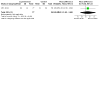


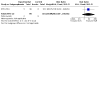
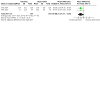
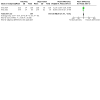


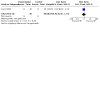
Update of
-
Interventions for intermittent exotropia.Cochrane Database Syst Rev. 2013 May 31;2013(5):CD003737. doi: 10.1002/14651858.CD003737.pub3. Cochrane Database Syst Rev. 2013. Update in: Cochrane Database Syst Rev. 2021 Sep 13;9:CD003737. doi: 10.1002/14651858.CD003737.pub4. PMID: 23728647 Free PMC article. Updated.
References
References to studies included in this review
Anand 2020 {published data only}
IXT1 2019 {published data only}
IXT2 2014 {published data only}
IXT2 2015 {unpublished data only}
Kiyak Yilmaz 2015 {published data only}
Kushner 1998a {published and unpublished data}
-
- Kushner BJ. Selective surgery for intermittent exotropia based on distance/near differences. Archives of Ophthalmology 1998;116(3):324-8. - PubMed
References to studies excluded from this review
Agrawal 2013 {published data only}
Akbari 2021 {published data only}
Alvarez 2020 {published data only}
-
- Alvarez TL, Scheiman M, Santos EM, Morales C, Yaramothu C, D'Antonio-Bertagnolli JV, et al. The Convergence Insufficiency Neuro-mechanism in Adult Population Study (CINAPS) randomized clinical trial: design, methods, and clinical data. Ophthalmic Epidemiology 2020;27(1):52-72. [DOI: 10.1080/09286586.2019.1679192] - DOI - PMC - PubMed
Chun 2020 {published data only}
Clarke 2015 {published data only}ISRCTN44114892
-
- Clarke M, Hogan V, Buck D, Shen J, Powell C, Speed C, et al. An external pilot study to test the feasibility of a randomised controlled trial comparing eye muscle surgery against active monitoring for childhood intermittent distance exotropia [X(T)]. Health Technology Assessment 2015;19(39):1-144. [DOI: 10.3310/hta19390] - DOI - PMC - PubMed
Farid 2018 {published data only}
Guo 2013 {published data only}
-
- Guo Y, Wang P, Qi ZY, Luo J, Zhang JM. Observation on postoperative binocular visual function reconstruction in intermittent exotropia children with binocular visual training. International Eye Science 2013;13(7):1338-40. [DOI: 10.3980/j.issn.1672-5123.2013.07.11] - DOI
Gupta 2017 {published data only}
Ha 2011 {published data only}
Hu 2012 {published data only}
-
- Hu XD, Chen J, Peng XJ, Yan SM, Yang MD. The effect of digital multimedia visual training applied after intermittent exotropia. International Eye Science 2012;12(7):1362-4. [DOI: 10.3969/j.issn.1672-5123.2012.07.44] - DOI
IXT2 2019 {published data only}
Jiang 2020 {published data only}
-
- Jiang J. Reconstruction effect of postoperative visual training on visual function in children with intermittent exotropia. International Eye Science 2020;20(5):914-6.
Kamal 2016 {published data only}
Kim 2018a {published data only}
Kim 2018b {published data only}
Nabie 2008 {published data only}
NCT03135938 {published data only}
-
- NCT03135938. Grading versus classic inferior oblique anterior transposition in patient with asymmetric dissociated vertical deviation. clinicaltrials.gov/ct2/show/NCT03135938 (first received 5 December 2019).
NCT03507712 {published data only}
-
- NCT03507712. Symmetrical versus asymmetrical surgery for asymmetrical inferior oblique overaction. clinicaltrials.gov/ct2/show/record/NCT03507712 (first received 5 December 2019).
Pan 2017 {published data only}
Qiu 2010 {published data only}
-
- Qiu H, Li XY, Li HY, Wang XL, Zhang JS. Binocular vision training after intermittent exotropia surgery. International Journal of Ophthalmology 2010;10:1522–3.
Qiu 2020 {published data only}
-
- Qiu YH, Yue ZQ. Influence of corneal plastic lens on ocular surface and visual quality of intermittent exotropia with myopia. International Eye Science 2020;20(5):911-3.
Rajavi 2017 {published data only}
Rajavi 2020 {published data only}
Rajavi 2021 {published data only}
Repka 2020 {published data only}
Sharma 2014 {published data only}
Sonwani 2017 {published data only}
Tan 2020 {published data only}
-
- Tan F, Yang X, Chu H, Yan L, Wiederhold BK, Wiederhold M, et al. The study of perceptual eye position examination and visual perceptual training in postoperative intermittent exotropes. Cyberpsychology, Behavior, and Social Networking 2020;23(12):871-5. [DOI: 10.1089/cyber.2020.0837] - PubMed
Wabbels 2016 {published data only}
Wang 2014 {published data only}
References to studies awaiting assessment
CTRI/2020/04/024480 {published data only}
-
- CTRI/2020/04/024480. Comparison of changes in decrease in lateral deviation in intermittent exotropia squint between bilateral and unilateral strabismus surgery. www.who.int/trialsearch/Trial2.aspx?TrialID=CTRI/2020/04/024480 (first received 04 July 2020).
ISRCTN04267774 {unpublished data only}ISRCTN04267774
-
- ISRCTN04267774. A feasibility study of a multi-centre randomised controlled trial of early versus late surgery for intermittent distance exotropia. www.controlled-trials.com/ISRCTN04267774 (first received 1 March 2013).
NCT04263103 {published data only}
-
- NCT04263103. A training software (SJ-RS-WL2015) rehabilitating intermittent exotropia binocular functions. clinicaltrials.gov/ct2/show/NCT04263103 (first received 10 February 2020).
NCT04308538 {published data only}
-
- NCT04308538. Bil. LR rec. using standard tables VS reduced numbers in intermittent exo. in children under 6. clinicaltrials.gov/ct2/show/NCT04308538 (first received 16 March 2020).
NCT04487249 {published data only}
-
- NCT04487249. Trial of vision therapy for intermittent exotropia (VT-IXT). clinicaltrials.gov/ct2/show/NCT04487249 (first received 27 July 2020).
NCT04617158 {published data only}
-
- NCT04617158. Comparing adjustable sutures surgery. clinicaltrials.gov/ct2/show/NCT04617158 (first received 5 November 2020).
References to ongoing studies
ACTRN12610001053011 {unpublished data only}
-
- ACTRN12610001053011. Surgery for intermittent exotropia: a comparison of outcomes following two different surgical techniques. apps.who.int/trialsearch/trial.aspx?trialid=ACTRN12610001053011 (first received 21 March 2013).
Additional references
Abroms 2001
-
- Abroms AD, Mohney BG, Rush DP, Parks MM, Tong PY. Timely surgery in intermittent and constant exotropia for superior sensory outcome. American Journal of Ophthalmology 2001;131(1):111-6. - PubMed
Adams 2008
Asjes‐Tydeman 2006
-
- Asjes-Tydeman WL, Groenewoud H, Wilt GJ. Timing of surgery for primary exotropia in children. Strabismus 2006;14(4):191-7. - PubMed
Baker 1979
-
- Baker JD, Davies GT. Monofixational intermittent exotropia. Archives of Ophthalmology 1979;97(1):93-5. - PubMed
Beneish 1994
-
- Beneish R, Flanders M. The role of stereopsis and early postoperative alignment in long term surgical results of intermittent exotropia. Canadian Journal of Ophthalmology 1994;29(3):119-24. - PubMed
Burian 1965
-
- Burian HM, Spivey BE. The surgical management of exodeviations. American Journal of Ophthalmology 1965;59:603. - PubMed
Burian 1966
-
- Burian HM. Exodeviations: their classification, diagnosis and treatment. American Journal of Ophthalmology 1966;62(6):1161-6. - PubMed
Burian 1971a
-
- Burian HM. Pathophysiology of exo deviations. In: Manley DR, editors(s). Symposium on Horizontal Ocular Deviations. St Louis (MO): Mosby Year Book, 1971:119.
Burian 1971b
Burke 1985
-
- Burke MJ. Intermittent exotropia. International Ophthalmology Clinics 1985;25:53-68. - PubMed
Caltrider 1983
-
- Caltrider N, Jampolsky A. Overcorrecting minus lens therapy for treatment of intermittent exotropia. Ophthalmology 1983;90(10):1160-5. - PubMed
Campos 1992
-
- Campos EC, Cipolli C. Binocularity and photophobia in intermittent exotropia. Perceptual and Motor Skills 1992;74(3 Pt 2):1168-70. - PubMed
Chia 2005
-
- Chia A, Seenyen L, Long QB. A retrospective review of 287 consecutive children in Singapore presenting with intermittent exotropia. Journal of AAPOS 2005;9(3):257-63. - PubMed
Chia 2007
Clarke 1981
-
- Clarke WN, Noel LP. Surgical results in intermittent exotropia. Canadian Journal of Ophthalmology 1981;16(2):66-9. - PubMed
Coffey 1992
-
- Coffey B, Wick B, Cotter S, Scharre J, Horner D. Treatment options in intermittent exotropia: a critical appraisal. Optometry and Vision Science 1992;69(5):386-404. - PubMed
Cooper 1976
-
- Cooper EL, Leyman IA. The management of intermittent exotropia. A comparison of the results of surgical and non surgical management. In: Orthoptics: past present and future. Transactions of the 3rd International Orthoptic Congress. New York: Stratton Intercontinental Medical Book Corp, 1976.
Cooper 1977
-
- Cooper J. Intermittent exotropia of the divergence excess type. Journal of the American Optometric Association 1977;48(10):1261-73. - PubMed
Cooper 1979
-
- Cooper J, Feldman J. Panoramic viewing, visual acuity of the deviating eye, and anomalous retinal correspondence in the intermittent exotrope of the divergence excess type. American Journal of Optometry and Physiological Optics 1979;56(7):422-9. - PubMed
Cooper 1982
Costenbader 1950
-
- Costenbader FD. The physiology and management of divergent strabismus. In: Allen JH, editors(s). Strabismic Ophthalmic Symposium. St Louis (MO): Mosby Year Book, 1950:353.
Covidence [Computer program]
-
- Veritas Health Innovation Covidence. Melbourne, Australia: Veritas Health Innovation, accessed 21 January 2021. Available at covidence.org.
Dadeya 2003
-
- Dadeya S, Kamlesh, Naniwal S. Usefulness of the preoperative prism adaptation test in patients with intermittent exotropia. Journal of Pediatric Ophthalmology and Strabismus 2003;40(2):85-9. - PubMed
Deeks 2017
-
- Deeks JJ, Higgins JPT, Altman DG, editor(s) on behalf of the Cochrane Statistical Methods Group. Chapter 9: Analysing data and undertaking meta-analyses. In: Higgins JPT, Churchill R, Chandler J, Cumpston MS, editor(s). Cochrane Handbook for Systematic Reviews of Interventions version 5.2.0 (updated June 2017), Cochrane, 2017. Available from training.cochrane.org/handbook/archive/v5.2.
Dunlap 1971
-
- Dunlap EA. Overcorrections in horizontal strabismus surgery. In: Symposium on Strabismus. Transactions of the New Orleans Academy of Ophthalmology. St Louis (MO): Mosby Year Book, 1971:255.
Edelman 1988
-
- Edelman PM, Brown MH, Murphree AL, Wright KW. Consecutive esodeviation ... Then what? American Orthopic Journal 1988;38:111-6.
Ekdawi 2008
Flynn 1975
-
- Flynn JT, McKenney S, Rosenhouse M. A method of feating intermittent divergence strabismus [Eine behandlungs form des intermittierenden divergenzschielens]. Klinische Monatsblatter fur Augenheilkunde 1975;167(2):185-90. - PubMed
Folk 1956
-
- Folk ER. Surgical results in intermittent exotropia. Archives of Ophthalmology 1956;55(4):484-7. - PubMed
France 1992
-
- France LW. The role of orthoptic therapy in exodeviations: a basis for orthoptic referral. American Orthoptic Journal 1992;42:52-64.
Freeman 1989
-
- Freeman RS, Isenberg SJ. The use of part-time occlusion for early onset unilateral exotropia. Journal of Pediatric Ophthalmology and Strabismus 1989;26(2):94-6. - PubMed
Glanville 2006
Goldrich 1980
-
- Goldrich SG. Optometric therapy of divergence excess strabismus. American Journal of Optometry and Physiological Optics 1980;57(1):7-14. - PubMed
Goldrich 1982
-
- Goldrich SG. Oculomotor biofeedback therapy for exotropia. American Journal of Optometry and Physiological Optics 1982;59(4):306-17. - PubMed
Govindan 2004
-
- Govindan M, Mohney BG, Diehl NN, Burke JP. Incidence and types of childhood exotropia. Ophthalmology 2005;112(1):104-8. - PubMed
Graham 1974
Haggerty 2004
Hardesty 1978
-
- Hardesty HH, Boynton JR, Keenan JP. Treatment of intermittent exotropia. Archives of Ophthalmology 1978;96(2):268-74. - PubMed
Hatt 2007
Hatt 2010a
Hatt 2010b
Hatt 2011
Hatt 2012
Higgins 2019
-
- Higgins JPT, Savović J, Page MJ, Elbers RG, Sterne JAC. Chapter 8: Assessing risk of bias in a randomized trial. In: Higgins JPT, Thomas J, Chandler J, Cumpston M, Li T, Page MJ, Welch VA, editor(s). Cochrane Handbook for Systematic Reviews of Interventions version 6.0 (updated July 2019). Cochrane, 2019. Available from training.cochrane.org/handbook/archive/v6.
Holmes 2007
Holmes 2011
Ing 1999
-
- Ing MR, Nishimura J, Okino L. Outcome study of unilateral lateral rectus recession for intermittent exotropia in children. Ophthalmic Surgery and Lasers 1999;30(2):110-7. - PubMed
Jampolsky 1962
-
- Jampolsky A. Management of exodeviations. In: Strabismus. Symposium of the New Orleans Academy of Ophthalmology. St Louis (MO): Mosby Year Book, 1962.
Jenkins 1992
-
- Jenkins R. Demographics geographic variations in the prevalence and management of exotropia. American Orthoptic Journal 1992;42:82-7.
Joyce 2015
-
- Joyce KE, Beyer F, Thomson RG, Clarke MP. A systematic review of the effectiveness of treatments in altering the natural history of intermittent exotropia. British Journal of Ophthalmology 2015;99(4):440-50. - PubMed
Keech 1990
-
- Keech RV, Stewart SA. The surgical overcorrection of intermittent exotropia. Journal of Pediatric Ophthalmology and Strabismus 1990;27(4):218-20. - PubMed
Knapp 1960
-
- Knapp P, Moore S. Intermittent exotropia. American Orthoptic Journal 1960;10:118-22. - PubMed
Koo 2006
Kushner 1998b
-
- Kushner BJ. The distance angle to target in surgery for intermittent exotropia. Archives of Ophthalmology 1998;116(2):189-94. [3126046] - PubMed
Kushner 1998c
-
- Kushner BJ, Morton GV. Distance/near differences in intermittent exotropia. Archives of Ophthalmology 1998;116(4):478-86. - PubMed
Kushner 1999
-
- Kushner BJ. Does overcorrecting minus lens therapy for intermittent exotropia cause myopia? Archives of Ophthalmology 1999;117(5):638-42. - PubMed
Maruo 2001
-
- Maruo T, Kubota N, Sakaue T, Usui C. Intermittent exotropia surgery in children: long term outcome regarding changes in binocular alignment. A study of 666 cases. Binocular Vision and Strabismus Quarterly 2001;16(4):265-70. - PubMed
Matsuo 2005
-
- Matsuo T, Matsuo C. The prevalence of strabismus and amblyopia in Japanese elementary school children. Ophthalmic Epidemiology 2005;12(1):31-6. - PubMed
Mitchell 2000
-
- Mitchell PR, Parks MM. Chapter 13: Concomitant exodeviations. In: Clinical Ophthalmology. Philadelphia: Harper Row and Company, 2000:1-17.
Mohney 2003
-
- Mohney B, Huffaker RK. Common forms of childhood exotropia. Ophthalmology 2003;110(11):2093-6. - PubMed
Mohney 2006
Mohney 2008
Moore 1969
-
- Moore S. The prognostic value of lateral gaze measurements in intermittent exotropia. American Orthoptic Journal 1969;19:69-71. - PubMed
Nusz 2005
-
- Nusz KJ, Mohney BJ, Diehl N. Female predominance in intermittent exotropia. American Journal of Ophthalmology 2005;140(3):546-7. - PubMed
O'Neal 1995
-
- O'Neal TD, Rosenbaum AL, Stathacopoulos RA. Distance stereoacuity improvement in intermittent exotropic patients following strabismus surgery. Journal of Pediatric Ophthalmology and Strabismus 1995;32(6):353-7. - PubMed
Ohtsuki 2001
-
- Ohtsuki H, Hasebe S, Kono R, Yamane T, Fujiwara H, Shiraga F. Prism adaptation response is useful for surgical outcome in selected types of intermittent exotropia. American Journal of Ophthalmology 2001;131(1):117-22. - PubMed
Parks 1975
-
- Parks M. Sensorial adaptations in strabismus. In: Duane TD, editors(s). Ocular Motility and Strabismus. Hagerstown (MD): Harper & Row, 1975:67.
PEDIG 2008
Petrunak 2004
-
- Petrunak JL, Rao RC, Baker JD. The evaluation of office control in X(T): a systematic approach. In: Faber JT , editors(s). Transactions of the 28th European Strabismological Association Meeting. London: Taylor and Francis, 2004:109-12.
Pratt‐Johnson 1969
-
- Pratt-Johnson J, Wee HS. Suppression associated with exotropia. Canadian Journal of Ophthalmology 1969;4(2):136-44. - PubMed
Pratt‐Johnson 1977
-
- Pratt-Johnson JA, Barlow JM, Tillson G. Early surgery in intermittent exotropia. American Journal of Ophthalmology 1977;84(5):689-94. - PubMed
Pratt‐Johnson 1979
-
- Pratt-Johnson JA Tillson G. Prismotherapy in intermittent exotropia. Canadian Journal of Ophthalmology 1979;14(4):243-5. - PubMed
Pratt‐Johnson 1994
-
- Pratt-Johnson JA, Tillson G. Management of Strabismus and Amblyopia: a Practical Guide. New York/Stuttgart: Thieme, 1994.
Raab 1969
-
- Raab EL, Parks MM. Recession of the lateral recti. Early and late postoperative alignments. Archives of Ophthalmology 1969;82(2):203-8. - PubMed
Ravault 1972
-
- Ravault AP, Bongrand G, Bonamour G. The utilization of prisms in the treatment of divergent strabismus. In: Orthoptics. Proceedings of the 2nd International Orthoptics Congress. Amsterdam: Excerpta Medica Foundation, 1972:77.
Repka 1991
-
- Repka MX, Arnoldi KA. Lateral incomitance in exotropia: fact or artifact? Journal of Pediatric Ophthalmology and Strabismus 1991;28(3):125-30. - PubMed
Review Manager Web 2021 [Computer program]
-
- The Cochrane Collaboration Review Manager Web (RevMan Web). Version 2.3.0. The Cochrane Collaboration, 2021. Available at revman.cochrane.org.
Richard 1983
-
- Richard JM, Parks MM. Intermittent exotropia. Surgical results in different age groups. Ophthalmology 1983;90(10):1172-7. - PubMed
Richardson 2001
-
- Richardson S. When is surgery indicated for distance exotropia? British Orthoptic Journal 2001;58:24-9.
Rowe 2009
-
- Rowe FJ, Noonan CP, Freeman G, Debell J. Intervention for intermittent distance exotropia with overcorrecting minus lenses. Eye 2009;23(2):320-5. - PubMed
Rutstein 1989
-
- Rutstein RP, Marsh-Tootle W, London R. Changes in refractive error for exotropes treated with overminus lenses. Optometry and Vision Science 1989;66(8):487-91. - PubMed
Rutstein 2003
-
- Rutstein RP, Corliss DA. The clinical course of intermittent exotropia. Optometry and Vision Science 2003;80(9):644‐9. - PubMed
Santiago 1999
-
- Santiago AP, Ing MR, Kushner BJ, Rosenbaum AL. Intermittent exotropia. In: Rosenbaum AL, Santiago AP, editors(s). Clinical Strabismus Management. Principles and Surgical Techniques. Philadelphia: WB Saunders Company, 1999:163‐75.
Scott 1975
-
- Scott AB, Mash JA, Jampolsky A. Quantitative guidelines for exotropia surgery. Investigative Ophthalmology 1975;14(6):428-36. - PubMed
Scott 1981
-
- Scott WE, Keech R, Mash AJ. The postoperative results and stability of exodeviations. Archives of Ophthalmology 1981;99(10):1814-8. - PubMed
Scott 1990
-
- Scott AB, Magoon EH, McNeer KW, Stager DR. Botulinum treatment of childhood strabismus. Ophthalmology 1990;97(11):1434-8. - PubMed
Spencer 1997
-
- Spencer RF, Tucker MG, Choi RY, McNeer KW. Botulinum toxin management of childhood intermittent exotropia. Ophthalmology 1997;104(11):1762-7. - PubMed
Spoor 1979
-
- Spoor DK, Hiles DA. Occlusion therapy for exodeviations occurring in infants and young children. Ophthalmology 1979;86(12):2152-7. - PubMed
Stathacopoulos 1993
-
- Stathacopoulos RA, Rosenbaum AL, Zanoni D, Stager DR, McCall LC, Ziffer AJ, et al. Distance stereoacuity. Assessing control in intermittent exotropia. Ophthalmology 1993;100(4):495-500. - PubMed
Stoller 1994
-
- Stoller SH, Simon JW, Lininger LL. Bilateral rectus recession for exotropia: a survival analysis. Journal of Pediatric Ophthalmology and Strabismus 1994;31(2):89-92. - PubMed
Suh 2006
-
- Suh YW, Kim SH, Lee JL, Cho YA. Conversion of intermittent exotropia types subsequent to part time occlusion. Graefe's Archive for Clinical and Experimental Ophthalmology 2006;244(6):705-8. - PubMed
Veronneau‐Troutman 1971
-
- Veronneau-Troutman S. Intermittent exotropia. International Ophthalmology Clinics 1971;11(4):114-9. - PubMed
von Noorden 1966
-
- Noorden GK. Some aspects of exotropia. In: Presented at Wilmers Residents' Association, John Hopkins Hospital, Baltimore. 1966.
von Noorden 2002
-
- Noorden GK, Campos EC. Binocular Vision and Ocular Motility: Theory and Management of Strabismus. 6th edition. St Louis (MO): Mosby, Inc, 2002.
Walklate 1998
-
- Walklate KJ. The role of diagnostic occlusion in distance exotropia. British Orthoptic Journal 1998;55:2-7.
Wang 1988
-
- Wang FM, Chryssanthou CO. Monocular eye closure in intermittent exotropia. Archives of Ophthalmology 1998;106(7):941-2. - PubMed
Watts 2005
-
- Watts P, Tippings E, Al-Madfai H. Intermittent exotropia, overcorrecting minus lenses, and the Newcastle scoring system. Journal of AAPOS 2005;9(5):460-4. - PubMed
Wickens 1984
-
- Wickens R. Results of surgery in distance exotropia. British Orthoptic Journal 1984;41:66-72.
Wiggins 1990
-
- Wiggins RE, Noorden GK. Monocular eye closure in sunlight. Journal of Pediatric Ophthalmology and Strabismus 1990;27(1):16-20. - PubMed
Wilson 1989
-
- Wilson ME, Parks MM. Primary inferior oblique overaction in congenital esotropia, accommodative esotropia and intermittent exotropia. Ophthalmology 1989;96(7):950-7. - PubMed
Yildirim 1999
-
- Yildirim C, Mutulu FM, Chen Y, Altinsoy HI. Assessment of central and peripheral fusion and near and distance stereoacuity in intermittent exotropia patients before and after strabismus surgery. American Journal of Ophthalmology 1999;128(2):222-30. - PubMed
Yildirim 2000
-
- Yildirim C, Altinsoy HI. Distance alternate-letter suppression test for objective assessment of sensorial status in intermittent exotropia. European Journal of Ophthalmology 2000;10(1):4-10. - PubMed
References to other published versions of this review
Hatt 2006
Publication types
MeSH terms
Associated data
Grants and funding
LinkOut - more resources
Full Text Sources
Medical
Miscellaneous

